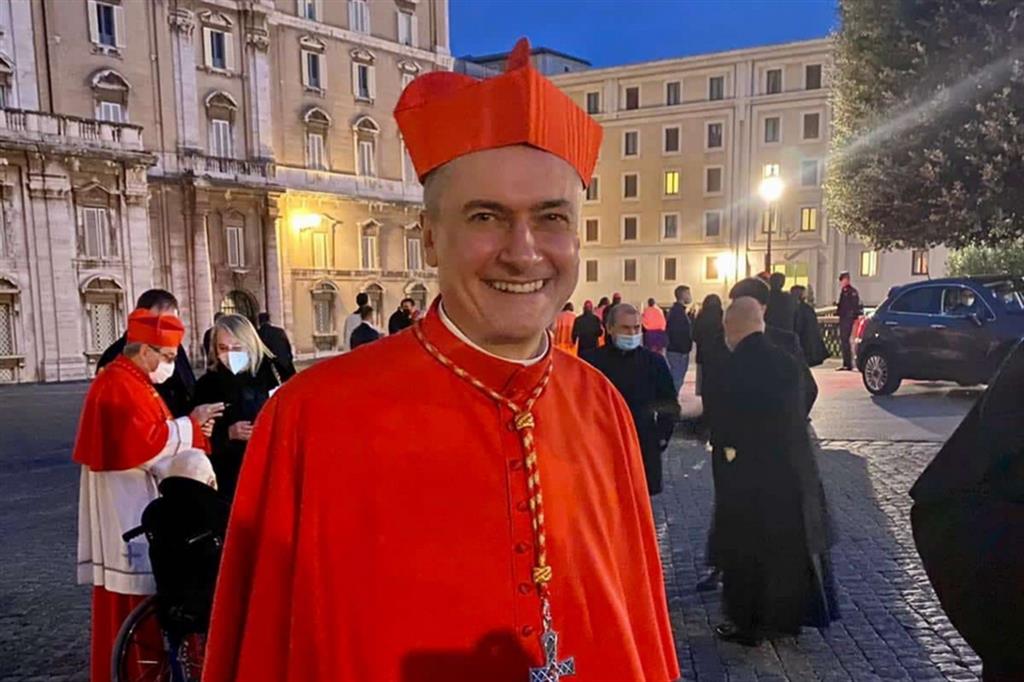
Cardinal Mauro Gambetti, a conventual Franciscan friar minor, now archpriest of St. Peter’s Basilica
On Sunday evening on the facade of St. Peter’s Basilica in Rome a videomapping will be projected that tells the life of the Fisherman of Galilee. The singer Andrea Bocelli will inaugurate the evening while the actor Flavio Insinna will be the narrator of the Apostle. Images taken from the most important iconographic repertoires of the Basilica and the Vatican Museums will alternate. It is a project born thanks to the collaboration of the Chapter, the parish, the Fabbrica di San Pietro and the Fratelli tutti Foundation. A project that is part of a path to make the Vatican Basilica more “sanctuary” and less “museum” and thus give “more light to the face of the Church”. Future interviewed Cardinal Mauro Gambetti, a conventual Franciscan friar minor, now archpriest of St. Peter’s Basilica after having been the custodian of the Sacred Convent of Assisi for years.
Your Eminence, what is the significance of this initiative?
Make St. Peter’s Basilica more clearly a revelatory place that can convey to people the meanings it holds, linked to the charism of Peter and his successors. Therefore, on the one hand, there is the attempt to make this place more and more a sanctuary, with worship, with the welcome of pilgrims, with an adequate pastoral care. On the other hand, there is the need to tell these meanings through other languages and communicate them to as many people as possible.
This is a desire of the archpriest but I also imagine that of the Pope …
Certainly. It’s one of the things he asked me when she mentioned me. My predecessor, Cardinal Angelo Comastri – with his great pastoral qualities, with his oratory art, with his profound spirituality – has already brought a wave in this sense. Now the Pope wants him to insist on promoting St. Peter’s as a sanctuary, avoiding the risk of it becoming a museum.
What do you mean?
Here the presence of tourists is prevalent who are attracted, but also distracted, by the monumentality of the Basilica. There are 40/50 thousand people a day, often accompanied by guides. This inevitably creates an almost museum atmosphere. With serious problems for those who want to access, come to pray or to participate in the liturgies. And that, for example, they cannot queue to enter and maybe have to queue for more than an hour.
How to overcome this problem?
We are making progressive attempts to make the Basilica more easily usable by the faithful who come to pray with preferential lanes distinct from tourists. And then with new proposals of devotion and spirituality. For example, we are studying a moment of prayer at least at noon in the Altar of the Confession of Peter, to keep alive the perception that we are inside the church that houses the tomb of the Prince of the Apostles. “Follow me” videomapping is also part of this context.
Meaning what?
The life of Peter projected on the facade illuminates the Basilica. On the other side it is the Basilica that illuminates Peter and his life. I believe this intertwining can give more light to the face of the Church, because we need to rediscover this man, his history of following Jesus, his charism which was then passed on to his successors, until today.
Will this initiative have a follow-up?
Certainly. Also in other fields, such as the scriptural and theological, historical and literary fields. In fact, in collaboration with Cardinal Gianfranco Ravasi, we will have one Lectio Petri who, starting from 25 October, will deepen the life of Peter and his ministry on a monthly basis. Not only. Together with the Cardinal Vicar of Rome, Angelo De Donatis, we are preparing a Petrine itinerary in the City to rediscover those places, we have identified seven of the Eternal City that are linked to the earthly life of Peter. An itinerary that will end on the evening of next June 28, the eve of the solemnity of Saints Peter and Paul, with a vigil here, on what used to be the Vatican Hill, the place of the martyrdom of the first of the apostles.
You are archpriest of the Vatican Basilica, but also president of the Fabbrica di San Pietro. In this capacity you have launched a concrete initiative, such as a school of arts and crafts. How was it born?
Spirituality, when authentic, is very concrete. It touches our flesh and our actions, our experience, even the economic one. So in the Basilica we live the cultic and pastoral dimension, while the Fabbrica deals with the material aspect, with a load of tradition and experience that we would like to develop also through this school.
Already in the eighteenth century there was one …
Yes. With interesting aspects in the field of labor law. Those who worked for the Fabbrica had a state-of-the-art welfare system for the time. And the economic treatment of working women was the same as that of men.
What is the purpose of this school?
Meanwhile, to train young people who can give continuity to the manual professions – at risk of extinction – that the Factory needs. But then also to prepare boys and girls from disadvantaged countries who can then practice these arts in their homeland.
How many will be the first pupils?
We start with small numbers, there will be 20, to which we will guarantee the free of all the educational path, as well as food and accommodation. In three sectors: marble workers and stonemasons; masons, plasterers and decorators; carpenters.
Together with these initiatives concerning the Basilica and the Fabbrica, the Fratelli Tutti Foundation was also born. What is the meaning of this initiative?
We felt the need for someone who was, so to speak, “on the threshold”. To meet the world. That there was something that somehow embodied Bernini’s Colonnade, something welcoming, but at the same time reaching out to those who are outside. In short, a place that allows people of any creed or religion to meet and talk to each other with the encyclical as its horizon All brothers. Because the Church is truly the champion of a universal brotherhood. Because fraternity is an exquisitely human value, but it takes a transcendent principle, a light from above for it to be possible to live it. Otherwise, despite her good intentions, she often twists into the exact opposite of her.
Vatican. Gambetti: «The basilica of San Pietro? Not a museum. Closer to the faithful ”

